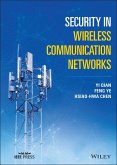

Alle Infos zum eBook verschenken

- Format: PDF
- Merkliste
- Auf die Merkliste
- Bewerten Bewerten
- Teilen
- Produkt teilen
- Produkterinnerung
- Produkterinnerung

Hier können Sie sich einloggen

Bitte loggen Sie sich zunächst in Ihr Kundenkonto ein oder registrieren Sie sich bei bücher.de, um das eBook-Abo tolino select nutzen zu können.
This book provides an in-depth guide to security in wireless ad hoc and sensor networks Security in Wireless Ad Hoc and Sensor Networks introduces the reader to the fundamentals and key issues related to wireless ad hoc networking, with an emphasis on security. It discusses the security attacks and counter measures in wireless ad hoc, sensor and mesh networks, and briefly presents the standards on related topics. The authors offer a clear exposition of various challenges and solutions in this field including bootstrapping, key distribution and exchange, authentication issues, privacy,…mehr
- Geräte: PC
- mit Kopierschutz
- eBook Hilfe
- Größe: 4.53MB
![Security for Wireless Ad Hoc Networks (eBook, PDF) Security for Wireless Ad Hoc Networks (eBook, PDF)]() Farooq AnjumSecurity for Wireless Ad Hoc Networks (eBook, PDF)107,99 €
Farooq AnjumSecurity for Wireless Ad Hoc Networks (eBook, PDF)107,99 €![Vehicular Ad Hoc Network Security and Privacy (eBook, PDF) Vehicular Ad Hoc Network Security and Privacy (eBook, PDF)]() Xiaodong LinVehicular Ad Hoc Network Security and Privacy (eBook, PDF)109,99 €
Xiaodong LinVehicular Ad Hoc Network Security and Privacy (eBook, PDF)109,99 €![Trust, Complexity and Control (eBook, PDF) Trust, Complexity and Control (eBook, PDF)]() Piotr CoftaTrust, Complexity and Control (eBook, PDF)98,99 €
Piotr CoftaTrust, Complexity and Control (eBook, PDF)98,99 €![Securing Wireless LANs (eBook, PDF) Securing Wireless LANs (eBook, PDF)]() Gilbert HeldSecuring Wireless LANs (eBook, PDF)107,99 €
Gilbert HeldSecuring Wireless LANs (eBook, PDF)107,99 €![Security in Wireless Communication Networks (eBook, PDF) Security in Wireless Communication Networks (eBook, PDF)]() Yi QianSecurity in Wireless Communication Networks (eBook, PDF)88,99 €
Yi QianSecurity in Wireless Communication Networks (eBook, PDF)88,99 €![Algorithms and Protocols for Wireless and Mobile Ad Hoc Networks (eBook, PDF) Algorithms and Protocols for Wireless and Mobile Ad Hoc Networks (eBook, PDF)]() Algorithms and Protocols for Wireless and Mobile Ad Hoc Networks (eBook, PDF)138,99 €
Algorithms and Protocols for Wireless and Mobile Ad Hoc Networks (eBook, PDF)138,99 €![Topology Control in Wireless Ad Hoc and Sensor Networks (eBook, PDF) Topology Control in Wireless Ad Hoc and Sensor Networks (eBook, PDF)]() Paolo SantiTopology Control in Wireless Ad Hoc and Sensor Networks (eBook, PDF)98,99 €
Paolo SantiTopology Control in Wireless Ad Hoc and Sensor Networks (eBook, PDF)98,99 €-
-
-
Dieser Download kann aus rechtlichen Gründen nur mit Rechnungsadresse in A, B, BG, CY, CZ, D, DK, EW, E, FIN, F, GR, HR, H, IRL, I, LT, L, LR, M, NL, PL, P, R, S, SLO, SK ausgeliefert werden.
- Produktdetails
- Verlag: John Wiley & Sons
- Seitenzahl: 280
- Erscheinungstermin: 30. Dezember 2008
- Englisch
- ISBN-13: 9780470516775
- Artikelnr.: 37293319
- Verlag: John Wiley & Sons
- Seitenzahl: 280
- Erscheinungstermin: 30. Dezember 2008
- Englisch
- ISBN-13: 9780470516775
- Artikelnr.: 37293319
- Herstellerkennzeichnung Die Herstellerinformationen sind derzeit nicht verfügbar.
Preface.
Acknowledgements.
List of Acronyms.
Part One Wireless Ad Hoc, Sensor and Mesh Networking.
1 Introduction.
1.1 Information Security.
1.2 Scope of the Book.
1.3 Structure of the Book.
1.4 Electronic Resources for the Book.
1.5 Review Questions.
2 Wireless Ad Hoc, Sensor and Mesh Networks.
2.1 Ad Hoc Networks and Applications.
2.2 Sensor and Actuator Networks.
2.3 Mesh Networks.
2.4 Tactical Communications and Networks.
2.5 Factors Influencing the Design of Wireless Ad Hoc, Sensor and Mesh
Networks.
.6 Review Questions.
3 The Wireless Medium.
3.1 Wireless Channel Fundamentals and Security.
3.2 Advanced Radio Technologies.
3.3 Review Questions.
4 Medium Access and Error Control.
4.1 Medium Access Control.
4.2 Error Control.
4.3 Wireless Metropolitan Area Networks.
4.4 Wireless Local Area Networks.
4.5 Wireless Personal Area Networks.
4.6 Review Questions.
5 Routing.
5.1 Internet Protocol and Mobile IP.
5.2 Routing in Wireless Ad Hoc Networks.
5.3 Routing in Wireless Sensor and Actuator Networks.
5.4 Review Questions.
6 Reliability, Flow and Congestion Control.
6.1 Reliability.
6.2 Flow and Congestion Control.
6.3 Review Questions.
7 Other Challenges and Security Aspects.
7.1 Localization and Positioning.
7.2 Time Synchronization.
7.3 Addressing.
7.4 Data Aggregation and Fusion.
7.5 Data Querying.
7.6 Coverage.
7.7 Mobility Management.
7.8 Cross-layer Design.
7.9 Review Questions.
Part Two Security in Wireless Ad Hoc, Sensor and Mesh Networking.
8 Security Attacks in Ad Hoc, Sensor and Mesh Networks.
8.1 Security Attacks.
8.2 Attackers.
8.3 Security Goals.
8.4 Review Questions.
9 Cryptography.
9.1 Symmetric Encryption.
9.2 Asymmetric Encryption.
9.3 Hash Functions and Message Authentication Code.
9.4 Cascading Hashing.
9.5 Review Questions.
10 Challenges and Solutions: Basic Issues.
10.1 Bootstrapping Security in Ad Hoc Networks.
10.2 Bootstrapping Security in Sensor Networks.
10.3 Key Distribution, Exchange and Management.
10.4 Authentication Issues.
10.5 Integrity.
10.6 Review Questions.
11 Challenges and Solutions: Protection.
11.1 Privacy and Anonymity.
11.2 Intrusion Detection.
11.3 Defense Against Traffic Analysis.
11.4 Access Control and Secure Human-Computer Interaction.
11.5 Software-Based Anti-Tamper Techniques.
11.6 Tamper Resilience: Hardware Protection.
11.7 Availability and Plausibility.
11.8 Review Questions.
12 Secure Routing.
12.1 Defense Against Security Attacks in Ad Hoc Routing.
12.2 Secure Ad Hoc Routing Protocols.
12.3 Further Reading.
12.4 Review Questions.
13 Specific Challenges and Solutions.
13.1 SPINS: Security Protocols for Sensor Networks.
13.2 Quarantine Region Scheme for Spam Attacks.
13.3 Secure Charging and Rewarding Scheme.
13.4 Secure Node Localization.
13.5 Secure Time Synchronization.
13.6 Secure Event and Event Boundary Detection.
13.7 Review Questions.
14 Information Operations and Electronic Warfare.
14.1 Electronic Support.
14.2 Electronic Attack.
14.3 Electronic Protection.
14.4 Review Questions.
15 Standards.
15.1 X.800 and RFC 2828.
15.2 Wired Equivalent Privacy (WEP).
15.3 Wi-Fi Protected Access (WPA).
References.
Index.
Preface.
Acknowledgements.
List of Acronyms.
Part One Wireless Ad Hoc, Sensor and Mesh Networking.
1 Introduction.
1.1 Information Security.
1.2 Scope of the Book.
1.3 Structure of the Book.
1.4 Electronic Resources for the Book.
1.5 Review Questions.
2 Wireless Ad Hoc, Sensor and Mesh Networks.
2.1 Ad Hoc Networks and Applications.
2.2 Sensor and Actuator Networks.
2.3 Mesh Networks.
2.4 Tactical Communications and Networks.
2.5 Factors Influencing the Design of Wireless Ad Hoc, Sensor and Mesh
Networks.
.6 Review Questions.
3 The Wireless Medium.
3.1 Wireless Channel Fundamentals and Security.
3.2 Advanced Radio Technologies.
3.3 Review Questions.
4 Medium Access and Error Control.
4.1 Medium Access Control.
4.2 Error Control.
4.3 Wireless Metropolitan Area Networks.
4.4 Wireless Local Area Networks.
4.5 Wireless Personal Area Networks.
4.6 Review Questions.
5 Routing.
5.1 Internet Protocol and Mobile IP.
5.2 Routing in Wireless Ad Hoc Networks.
5.3 Routing in Wireless Sensor and Actuator Networks.
5.4 Review Questions.
6 Reliability, Flow and Congestion Control.
6.1 Reliability.
6.2 Flow and Congestion Control.
6.3 Review Questions.
7 Other Challenges and Security Aspects.
7.1 Localization and Positioning.
7.2 Time Synchronization.
7.3 Addressing.
7.4 Data Aggregation and Fusion.
7.5 Data Querying.
7.6 Coverage.
7.7 Mobility Management.
7.8 Cross-layer Design.
7.9 Review Questions.
Part Two Security in Wireless Ad Hoc, Sensor and Mesh Networking.
8 Security Attacks in Ad Hoc, Sensor and Mesh Networks.
8.1 Security Attacks.
8.2 Attackers.
8.3 Security Goals.
8.4 Review Questions.
9 Cryptography.
9.1 Symmetric Encryption.
9.2 Asymmetric Encryption.
9.3 Hash Functions and Message Authentication Code.
9.4 Cascading Hashing.
9.5 Review Questions.
10 Challenges and Solutions: Basic Issues.
10.1 Bootstrapping Security in Ad Hoc Networks.
10.2 Bootstrapping Security in Sensor Networks.
10.3 Key Distribution, Exchange and Management.
10.4 Authentication Issues.
10.5 Integrity.
10.6 Review Questions.
11 Challenges and Solutions: Protection.
11.1 Privacy and Anonymity.
11.2 Intrusion Detection.
11.3 Defense Against Traffic Analysis.
11.4 Access Control and Secure Human-Computer Interaction.
11.5 Software-Based Anti-Tamper Techniques.
11.6 Tamper Resilience: Hardware Protection.
11.7 Availability and Plausibility.
11.8 Review Questions.
12 Secure Routing.
12.1 Defense Against Security Attacks in Ad Hoc Routing.
12.2 Secure Ad Hoc Routing Protocols.
12.3 Further Reading.
12.4 Review Questions.
13 Specific Challenges and Solutions.
13.1 SPINS: Security Protocols for Sensor Networks.
13.2 Quarantine Region Scheme for Spam Attacks.
13.3 Secure Charging and Rewarding Scheme.
13.4 Secure Node Localization.
13.5 Secure Time Synchronization.
13.6 Secure Event and Event Boundary Detection.
13.7 Review Questions.
14 Information Operations and Electronic Warfare.
14.1 Electronic Support.
14.2 Electronic Attack.
14.3 Electronic Protection.
14.4 Review Questions.
15 Standards.
15.1 X.800 and RFC 2828.
15.2 Wired Equivalent Privacy (WEP).
15.3 Wi-Fi Protected Access (WPA).
References.
Index.







